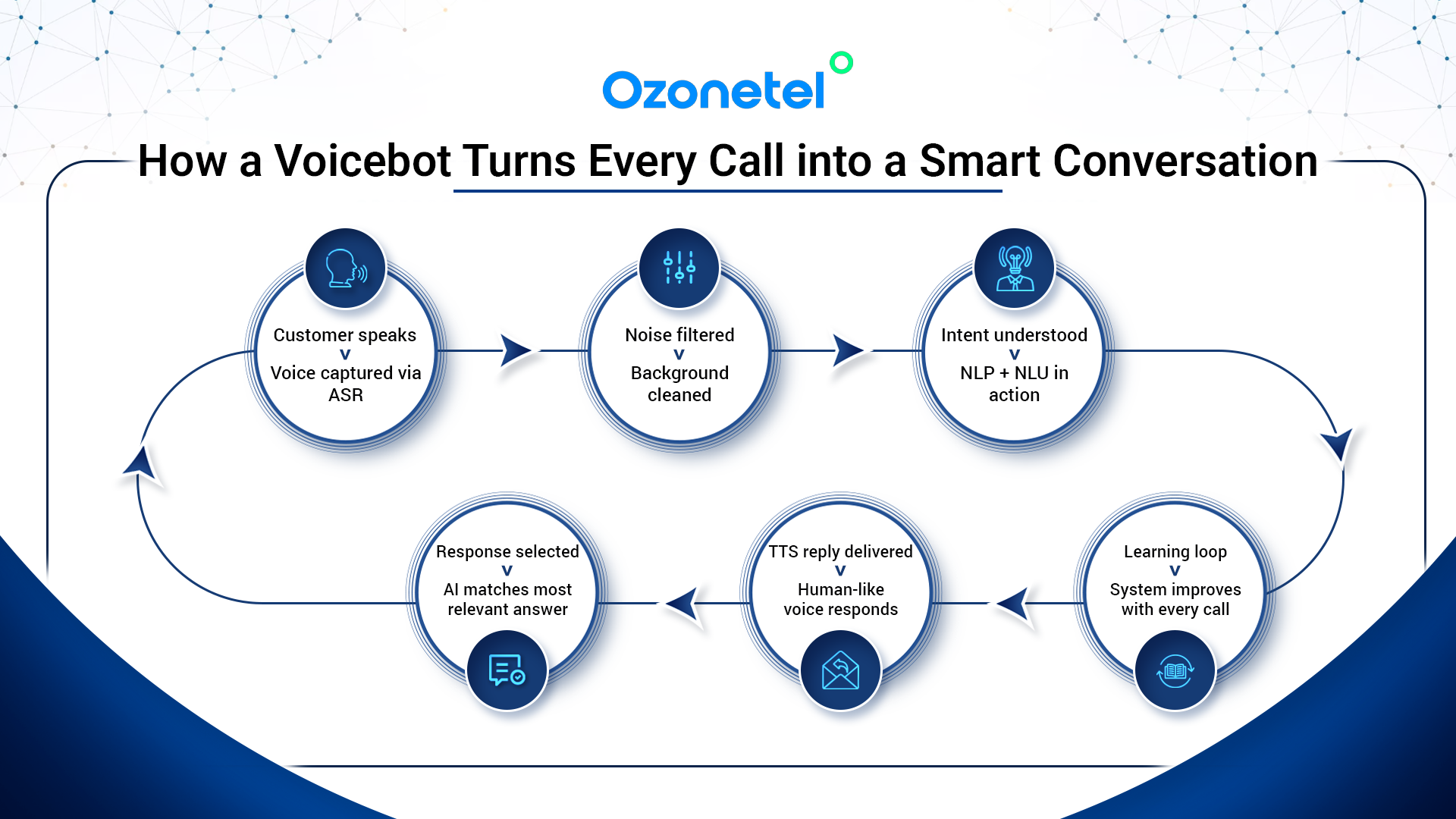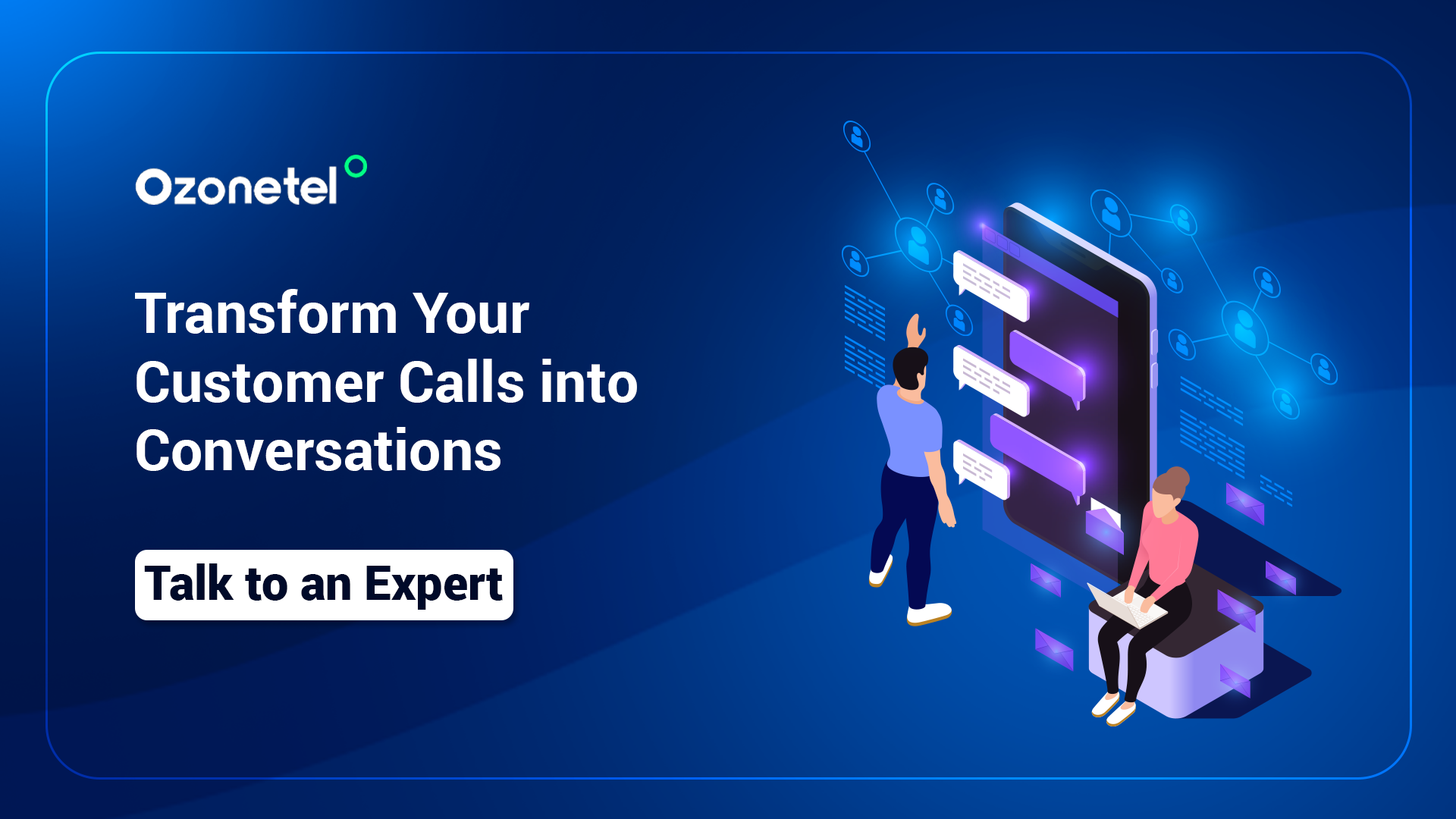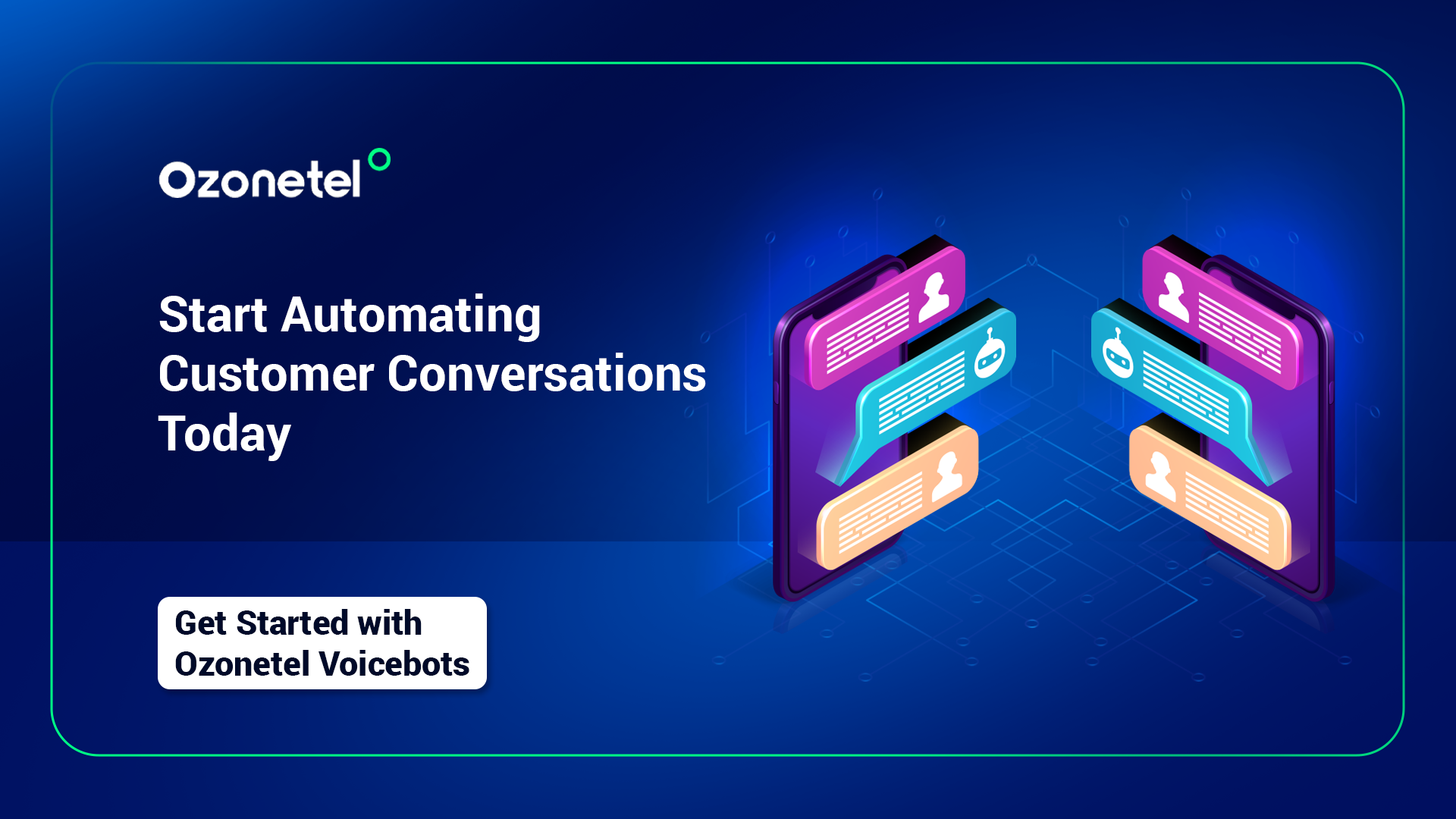- Resources
- How Voicebots are Transforming Customer Interaction
How Voicebots are Transforming Customer Interaction

You might be able to pick up the phone in seconds, but can you resolve 10,000 calls in a day without losing quality? That’s the hard part. Many support operations struggle with consistency.
Voicebots help by delivering reliable, repeatable, and context-aware voice interactions around the clock. These are AI-trained systems that recognize voice, understand meaning, and respond with accuracy. They handle high-volume queries, personalize responses, and scale better than human teams alone.
In this post, we’ll explain what voicebots are, how they’re built, and why they’ve become essential to delivering consistent customer experiences at scale.
In this article, we will explore:
How Do Voicebots Work?
Voicebots use artificial intelligence to carry outspoken conversations with customers: understanding what’s said, identifying intent, and replying with relevant responses in real time.
These systems are more than just voice-controlled tools; they listen, interpret, and respond just like a human would in a call center, but with higher consistency, accuracy, and scale. 
Here’s a breakdown of how a voicebot processes and responds during a typical interaction:
Step 1: Listening to the Input
The voice bot starts by capturing the customer’s voice input through automated speech recognition (ASR). ASR helps it understand spoken words by converting them into machine-readable text. It picks up not just words but tone, speed, pauses, and accent, allowing the bot to detect what the speaker is saying and how they’re saying it.
Step 2: Removing Distractions
To focus on the actual query, the bot filters out irrelevant background noise, such as traffic, chatter, or static. This is done using acoustic models and deep learning frameworks that distinguish between noise and meaningful speech. This step helps make sure that the bot interprets the voice input accurately, even in noisy environments.
Step 3: Understanding What’s Being Asked
Once the voice is converted to text and cleaned up, the system uses natural language processing (NLP) and natural language understanding (NLU) to figure out what the customer actually wants. This is where intent recognition kicks in: is the customer checking a balance, requesting a callback, or asking for support?
The bot also considers sentiment cues and context from past conversations if available, helping it decide how to respond appropriately.
Step 4: Interpreting Meaning and Context
The voicebot doesn’t just match keywords. It uses semantic analysis (to grasp the meaning of words and phrases) and syntactic analysis (to follow grammatical patterns) to make sense of the entire sentence. This helps the bot pick up on details like urgency, request type, or even sarcasm in some cases.
Step 5: Deciding the Best Response
After understanding the intent and context, the bot compares the query to a library of trained responses. It ranks possible answers based on what’s most relevant, accurate, and actionable. If the user’s query is complex or unclear, the bot may ask for clarification or route the call to a human agent with all the context intact.
Step 6: Speaking the Response Back
Finally, the selected response is converted back to speech using text-to-speech (TTS) technology. The bot’s voice is not robotic by default; it can be customized to sound more natural, friendly, and in line with your brand or industry. This makes the customer interaction smoother and more relatable for the customer.
Benefits of Voicebots
Traditional automated phone systems fall short because they rely heavily on static scripts, long wait times, and disconnected systems. Voicebots, powered by AI, solve this by automating voice-based conversations while keeping the experience fluid and human-like. 
Here’s a breakdown of how they work in real scenarios to improve customer experience meaningfully.
24/7 Availability
Voicebots are always on. You don’t have to worry about holidays, weekends, or shift coverage. They respond to customer calls any time—during off-hours, at night, or when your human agents are unavailable. This means customers don’t have to wait until business hours to get help. By being available around the clock, you build a support experience that’s dependable and responsive.
Faster Response Time
Voicebots eliminate call queue wait times. As soon as a customer reaches out, the voicebot picks up and starts assisting. It can handle multiple calls at the same time, so there’s no delay during peak hours. This directly reduces friction and speeds up the time it takes to resolve common queries. Faster responses often translate to higher customer satisfaction.
Cost-Effective
With voicebots, you don’t need to scale your workforce for basic queries. Instead of hiring more agents to handle repetitive calls, voicebots can take over these tasks. This reduces payroll and training costs while still maintaining a high standard of service. You’re able to serve more customers without proportionally increasing your overhead.
Improved Customer Satisfaction
When customers are heard promptly, given clear answers, and don’t have to repeat themselves, satisfaction improves. Voicebots maintain a consistent tone, avoid human errors, and offer reliable answers every time. This leads to fewer escalations and a more seamless interaction for the customer, making them more likely to return.
Scalable
During high-demand periods like sale days, product launches, or unexpected traffic spikes, voicebots can manage call volume without affecting response quality. They scale automatically, handling thousands of calls simultaneously, which human teams can’t match. This ability to handle volume while maintaining quality is key to delivering consistent service.
Human-like Experience
Modern voicebots use conversational AI that sounds natural. They can adjust to tone, pause at the right moments, and respond appropriately to different customer moods. This makes the interaction feel less like a machine and more like a helpful conversation. Customers are more likely to stay engaged when the bot doesn’t sound mechanical or repetitive.
Natural language understanding and processing
Voicebots understand how people speak. Using Natural Language Processing (NLP) and Natural Language Understanding (NLU), they process not just keywords but entire phrases, context, and intent. This allows them to respond meaningfully, even when customers phrase things differently or use informal language.
Personalized customer interactions
Voicebots can pull customer data from integrated systems to personalize conversations. For example, they can greet a customer by name, refer to their last purchase, or recall a previous issue. This context-driven dialogue makes the customer feel valued and understood, not just another ticket in a queue.
Seamless integration with CRMs and other systems
Voicebots don’t work in isolation. They connect with your CRM, helpdesk, and ticketing tools, allowing them to fetch real-time data, log call details, update customer records, and trigger follow-up actions. Integrated bots create continuity, so customers don’t have to repeat their story across channels.
Improves Self-Service Capability
Customers prefer solving simple issues themselves when given the tools to do so. Voicebots help by walking them through processes like checking account status, making payments, or scheduling appointments without needing an agent. This makes your self-service channel more efficient and lowers dependency on human support.
Improves Employee Productivity
Voicebots take over the repetitive workload, like answering balance inquiries, resetting passwords, or confirming orders. This frees up human agents to deal with high-priority or complex issues that require empathy or problem-solving. It creates a balanced system where human effort is spent where it adds the most value.
Self-Training and Onboarding
Voicebots learn continuously. Through AI and machine learning, they adapt based on past conversations and new inputs. You can also update them quickly with new flows or FAQs. This makes it easier to introduce process changes without extensive re-training, allowing your support setup to stay relevant and updated with less effort.
How Do Ozonetel Voicebots Help in Improving Customer Interactions
From automating collections to powering large-scale outreach and providing 24/7 self-service, Ozonetel Voice AI Agents are actively improving how India’s top banks, NBFCs, and enterprises interact with their customers.

Here’s a closer look at how Ozonetel Voicebots drive better customer interactions:
Automated Conversations That Feel Personal
Ozonetel’s voicebots integrate directly with your CRM and internal databases to generate fully personalized calls. Each call can reference the customer’s name, account status, or due amount dynamically, so the message feels relevant from the start.
For example, a leading rural NBFC uses the CX platform to send repayment reminders to over five million customers monthly. Every message is personalized, triggered at the right time, and delivered without human intervention. This level of automation helped them cut turnaround time by half when compared to manual follow-ups.
Smarter Collections Through Intelligent Call Handling
For high-volume financial institutions, collections is a key use case. One of India’s top private banks now automates its collections workflow entirely using Ozonetel’s voicebots. Based on how a customer responds—positively, negatively, or not at all—the bot updates dispositions in real time.
If the customer agrees to pay, the bot tags the call and ends it. If the customer is uncooperative, it delivers required legal messages and flags the case for manual follow-up. This setup saved the bank an average of three hours per agent, per day—freeing up resources while keeping operations consistent.
Real-Time Sentiment Detection and Smarter Routing
Voicebots don’t just respond—they understand. Using intent recognition and sentiment detection, Ozonetel’s bots assess the nature of the conversation in real time. Based on the outcome, they either close the query, schedule a callback, or route the call to a live agent with all the required context.
Muthoot Gold, for instance, used this capability to improve collections by 8%, simply by segmenting calls better and routing only the ones that needed human attention.
Human-Like Conversations, Powered by GenAI
These voice bots are not limited to scripted replies. Built using large language models (LLMs), they respond in a way that sounds natural and engaging. They use speech recognition (ASR), text-to-speech (TTS), and contextual memory to hold conversations that feel closer to human interaction—matching tone, speed, and flow.
This leads to fewer escalations, better call containment, and a smoother experience across the board.
24/7 Availability With Seamless Agent Escalation
When a query is simple, the bot can resolve it instantly—think account balances, payment statuses, or appointment confirmations. But when an issue requires human input, the bot passes it off to the right agent using skill-based routing.
This escalation happens with full context, so the customer never has to repeat themselves. It’s a hybrid system where automation handles volume, and agents step in only when truly needed.
Easy Integration and Continuous Improvement
Ozonetel voice bots are designed to plug into your existing tech stack. They work across CRM platforms, core banking software, ticketing systems, and telephony infrastructure, so you don’t have to rebuild your processes.
What’s more, every interaction feeds back into the system. The bot learns from previous conversations and continuously updates its decision-making, improving accuracy and relevance over time. 
Conclusion
Customer expectations have changed—they want quick, clear, and hassle-free support, no matter when they reach out. Traditional phone systems struggle to keep up, often creating more friction than value.
Voicebots step in to fix this. They offer immediate, 24/7 assistance, handle high volumes without stress, and provide a consistent, human-like experience that customers actually enjoy. Whether you’re dealing with common queries, seasonal spikes, or after-hours calls, voicebots help you stay responsive without adding pressure on your support team.
Ready to experience the difference firsthand? Schedule a demo with Ozonetel now and see how voice automation can make your customer support faster, smarter, and more scalable.
Ozonetel helps teams deliver CX faster with lower costs
Frequently Asked Questions
Ozonetel’s cloud-native architecture enables businesses to go live in days—not weeks or months like many traditional enterprise platforms. With minimal IT dependencies and simple API integrations, deployment is frictionless even at scale. In contrast, Genesys implementations often involve complex setup cycles and customization layers that can extend timelines, especially for mid-market or multi-location rollouts.
Ozonetel’s 24/7 customer support is known for its hands-on, personalized approach. During high-traffic periods or service disruptions, businesses often cite Ozonetel’s faster response times and proactive resolution compared to Genesys’ ticket-driven escalation model. The local presence and dedicated success teams make Ozonetel a more agile partner in critical moments.
Genesys offers extensive analytics capabilities, but Ozonetel bridges the gap with real-time dashboards, customizable reports, and AI-powered conversation intelligence. Users gain actionable visibility into agent performance, call quality, and customer sentiment without needing external tools or data teams. Ozonetel’s unified analytics also eliminate silos—something that’s harder to achieve with Genesys’ multi-module architecture.
Ozonetel is built to scale horizontally. Whether it’s a startup expanding across regions or an enterprise managing thousands of concurrent interactions, the platform adapts without costly migrations or infrastructure overhauls. Genesys offers strong scalability too, but with higher costs, licensing complexities, and longer configuration cycles that can slow down agility as you grow.
Genesys has long been associated with advanced automation, but Ozonetel has quickly closed the gap with AI-first tools like conversational intelligence, real-time agent assist, and customer journey automation. What sets Ozonetel apart is accessibility—AI is embedded natively into the platform, making it easier and faster for teams to deploy without external integrations or added costs.









